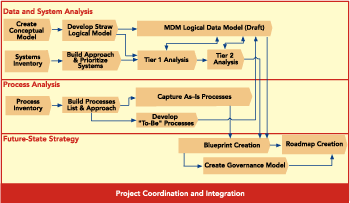LESSON - Master Data Management: Getting the Most from an MDM Initiative
Matthew J. Beyer, Senior Architect, Collaborative Consulting
Without a doubt, master data management can help a company do business much more efficiently. When an entire organization and its partners understand the same information to have the same meaning, the company can make and sell products faster, connect more effectively with suppliers and customers, improve business process efficiency, and simply make more money. An MDM initiative also helps a company improve its data quality and consistency; develop applications more efficiently; and eliminate the costs and waste born of poorly managed data. But organizations are discovering that an enterprise MDM initiative can be a complex and expensive endeavor.
Cooperation and Sacrifice
In fact, preparing for an MDM initiative requires substantial cooperation among numerous internal and external groups—a tall order for many organizations. To work optimally, people from several functions and departments must come to a consensus on master data—what comprises it, what defines it, and what its sources are. Some departments may have to make sacrifices and endure dramatic changes.
An MDM project’s scope must be defined clearly to realize its promise. When teams maintain a sharp focus, gains made via MDM are often real and significant. Identifying business value–based focus areas is critical. Initiatives such as supplier and product “on-boarding,” customer retention, and transportation optimization create an impetus for MDM as well as a tangible system and information scope. This focus, however, often means that not all parties benefit in the near term. As a result, prioritization and flexibility also become critical.
Executives considering an MDM initiative can learn a valuable lesson from organizations that have tried to tackle an enterprise data warehouse all at once. Many large scale data warehouse projects include many, if not all, of a company’s subject areas. This approach is risky because of the lengthy time frame involved and the extreme complexity in developing an entire solution on the first pass. A safer, more effective approach, one that assesses, prioritizes, and implements iteratively, has a much higher chance of success. This also holds true with MDM.
By assessing the existing environment, prioritizing areas that reap the greatest benefits, and implementing in a phased manner, success is considerably more likely than with a “big-bang” method.
Multi-Phase Approach
Once the strategy has been defined, a practical, multi-phase approach must be developed. The first phase (technologyand data management) entails assessment and analysis of systems and applicationswith regard to master data—where data isstored and how it is managed or used. Italso includes activities that define masterdata and develop a logical data model.
The second phase concerns business processand data quality—documentingexisting processes and developing futureones to support the solution. Master datamanagement is as much about process improvement as technology implementation.A data governance phase follows.Many projects/systems falter due to a lackof ongoing sponsorship and commitment.What once seemed like the right solution, ifnot constantly revisited and updated, mayquickly become inappropriate in a rapidlyshifting business climate. It is especiallycritical to identify definitive data and datamanagement process owners to create theappropriate environment for clear datadefinition, consistent data management,and accountability for data availability andquality. Establishing a governance modelthat will work within the targeted organizationis integral to long-term success.
Keep it Real
Finally, companies need to employ a soliddose of realism. Often, MDM is not aboutcentralizing data into a single tool, butcentralized management of data across theexisting application set. It may be moreprudent to extend the capabilities of theexisting applications and improve dataintegration than to try to implement acentralized MDM toolset. Sensible, pragmaticexpectations are critical; in fact, the companies that have the most success with MDM are honest with themselves, employ a practical approach, and maintain a holistic, open-minded perspective.

This article originally appeared in the issue of .